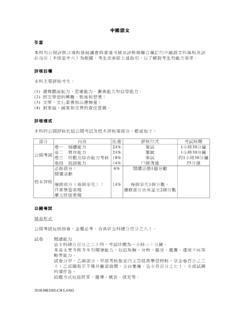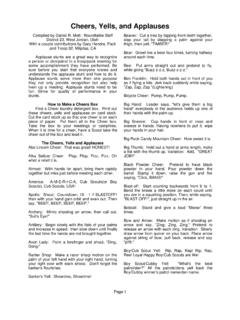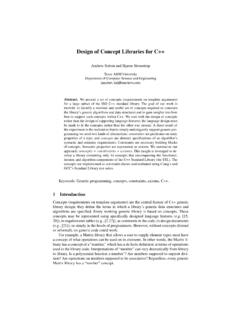Transcription of STAR manual 2.5 - Cornell University
1 star manual Alexander Dobin January 19, 2016. Contents 1 Getting started. 3. Installation.. 3. Installation - in depth and troubleshooting.. 3. Basic workflow.. 3. 2 Generating genome indexes. 4. Basic options.. 4. Advanced options.. 5. Which chromosomes/scaffolds/patches to include? .. 5. Which annotations to use? .. 5. Annotations in GFF format.. 6. Using a list of annotated junctions.. 6. Very small genome.. 6. Genome with a large number of references.. 6. 3 Running mapping jobs. 6. Basic options.. 6. Advanced options.. 7. Using annotations at the mapping stage.. 7. ENCODE options .. 7. 4 Output files. 8. Log files.. 8. SAM.. 8. Multimappers.. 8. SAM attributes.. 9. Compatibility with Cufflinks/Cuffdiff.. 9. Unsorted and sorted-by-coordinate BAM.
2 10. Splice junctions.. 10. 1. 5 Chimeric and circular alignments. 11. star -Fusion.. 11. Chimeric alignments in the main BAM files.. 11. Chimeric alignments in .. 11. Chimeric alignments in .. 12. 6 Output in transcript coordinates. 13. 7 Counting number of reads per gene. 14. 8 2-pass mapping. 14. Multi-sample 2-pass mapping.. 14. Per-sample 2-pass mapping.. 14. 2-pass mapping with re-generated genome.. 15. 9 Description of all options. 15. Parameter Files .. 16. System .. 16. Run Parameters .. 16. Genome Parameters .. 17. Genome Generation Parameters .. 18. Splice Junctions Database .. 18. Input Files .. 20. Read Parameters .. 20. Limits .. 21. Output: general .. 22. Output: SAM and BAM .. 24. BAM processing .. 28. Output Wiggle .. 28. Output Filtering.
3 29. Output Filtering: Splice Junctions .. 31. Scoring .. 32. Alignments and Seeding .. 33. Windows, Anchors, Binning .. 36. Chimeric Alignments .. 37. Quantification of Annotations .. 38. 2-pass Mapping .. 39. 2. 1 Getting started. Installation. star source code and binaries can be downloaded from GitHub: named releases from https: , or the master branch from alexdobin/ star . The pre-compiled star executables are located bin/ subdirectory. The static executables are the easisest to use, as they are statically compiled and are not dependents on external libraries. To compile star from sources run make in the source directory for a Linux-like environment, or run make STARforMac for Mac OS X. This will produce the executable ' star ' inside the source directory.
4 Installation - in depth and troubleshooting. star is compiled with gcc c++ compiler and depends only on standard gcc libraries. Some generic instructions on installing correct gcc environments are given below. Ubuntu. $ sudo apt-get update $ sudo apt-get install g++. $ sudo apt-get install make Red Hat, CentOS, Fedora. $ sudo yum update $ sudo yum install make $ sudo yum install gcc-c++. $ sudo yum install glibc-static SUSE. $ sudo zypper update $ sudo zypper in gcc gcc-c++. Mac OS X. Current versions of Mac OS X Xcode are shipped with Clang replacing the standard gcc compiler. Presently, standard Clang does not support OpenMP which creates problems for star compilation. One option to avoid this problem is to install gcc (preferrably using homebrew package manager).
5 Another option is to add OpenMP functionality to Clang. Basic workflow. Basic star workflow consists of 2 steps: 1. Generating genome indexes files (see Section 2. Generating genome indexes. In this step user supplied the reference genome sequences (FASTA files) and annota- tions (GTF file), from which star generate genome indexes that are utilized in the 3. 2nd (mapping) step. The genome indexes are saved to disk and need only be generated once for each genome/annotation combination. A limited collection of star genomes is available from star genomes/, however, it is strongly recommended that users generate their own genome indexes with most up-to-date assemblies and annotations. 2. Mapping reads to the genome (see Section 3. Running mapping jobs).)
6 In this step user supplies the genome files generated in the 1st step, as well as the RNA-seq reads (sequences) in the form of FASTA or FASTQ files. star maps the reads to the genome, and writes several output files, such as alignments (SAM/BAM), mapping summary statistics, splice junctions, unmapped reads, signal (wiggle) tracks etc. Output files are described in Section 4. Output files. Mapping is controlled by a variety of input parameters (options) that are described in brief in Section 9. Description of all options, and in more detail in Section 3. Running mapping jobs. star command line has the following format: star --option1-name option1-value(s)--option2-name option2-value(s) .. If an option can accept multiple values, they are separated by spaces, and in a few cases - by commas.
7 2 Generating genome indexes. Basic options. The basic options to generate genome indices are as follows: --runThreadN NumberOfThreads --runMode genomeGenerate --genomeDir /path/to/genomeDir --genomeFastaFiles /path/to/genome/fasta1 /path/to/genome/fasta2 .. --sjdbGTFfile /path/ --sjdbOverhang ReadLength-1. --runThreadN option defines the number of threads to be used for genome generation, it has to be set to the number of available cores on the server node. --runMode genomeGenerate option directs star to run genome indices generation job. --genomeDir specifies path to the directory (henceforth called genome directory where the genome indices are stored. This directory has to be created (with mkdir) before star run and needs to writing permissions.)
8 The file system needs to have at least 100GB of disk space available for a typical mammalian genome. It is recommended to remove all files from the genome directory before running the genome generation step. This directory path will have to be supplied at the mapping step to identify the reference genome. --genomeFastaFiles specified one or more FASTA files with the genome reference sequences. Multiple reference sequences (henceforth called chromosomes) are allowed for each fasta file. You can rename the chromosomes names in the keeping the order of the chromo- somes in the file: the names from this file will be used in all output alignment files (such as .sam). The tabs are not allowed in chromosomes names, and spaces are not recommended. 4. --sjdbGTFfile specifies the path to the file with annotated transcripts in the standard GTF.
9 Format. star will extract splice junctions from this file and use them to greatly improve accuracy of the mapping. While this is optional, and star can be run without annotations, using annotations is highly recommended whenever they are available. Starting from , the annotations can also be included on the fly at the mapping step. --sjdbOverhang specifies the length of the genomic sequence around the annotated junction to be used in constructing the splice junctions database. Ideally, this length should be equal to the ReadLength-1, where ReadLength is the length of the reads. For instance, for Illumina 2x100b paired-end reads, the ideal value is 100-1=99. In case of reads of varying length, the ideal value is max(ReadLength)-1. In most cases, the default value of 100 will work as well as the ideal value.
10 Genome files comprise binary genome sequence, suffix arrays, text chromosome names/lengths, splice junctions coordinates, and transcripts/genes information. Most of these files use internal star format and are not intended to be utilized by the end user. It is strongly not recommended to change any of these file with one exception: you can rename the chromosome names in the keeping the order of the chromosomes in the file: the names from this file will be used in all output files ( SAM/BAM). Advanced options. Which chromosomes/scaffolds/patches to include? It is strongly recommended to include major chromosomes ( , for human chr1-22,chrX,chrY,chrM,). as well as un-placed and un-localized scaffolds. Typically, un-placed/un-localized scaffolds add just a few MegaBases to the genome length, however, a substantial number of reads may map to ribosomal RNA (rRNA) repeats on these scaffolds.







